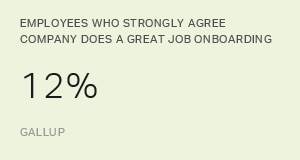Story Highlights
- Identify what your organization values
- Make sure your values appear in every stage of the employee life cycle
- The manager experience is key to the employee experience
Most people are familiar with the employee life cycle -- the stages an employee goes through with an organization, from attraction to getting hired, through employment to eventual departure.
More important than the life cycle, however, is the employee experience -- the journey people take with your organization and the interactions they have with managers and associates at each stage of the life cycle.
That experience directly affects employee performance and your employment brand, and it is rooted in your organizational culture.
It's more important than ever that organizations strategically and thoughtfully manage every step of the employee experience because what happens within organizations from attraction through departure is communicated widely through social media outlets.
And your existing top talent and prospective star employees are paying attention.
Those stars are carefully looking to join an organizational culture that matches its pre-hire promises, and companies can no longer hide behind a brand name or past reputation.
Star employees are also on the move.
And your existing top talent and prospective star employees are paying attention.
About one-third of U.S. workers have changed jobs in the past three years, and nine in 10 of those who have changed jobs have changed companies.
Employees do not see a future with their current organizations.
Part of the problem is, only 27% of U.S. workers strongly agree that they believe in their organization's values.
How can organizations strengthen the employee experience -- and thus their culture and brand -- so they can attract and keep top talent?
The first step is to identify what your organization values.
Why does your organization exist -- your purpose -- and what do you want your brand to represent?
Employees do not see a future with their current organizations.
Your purpose and brand need to be reflected in a real way at each stage of the life cycle -- manifested through the cultural norms that are developed in everyday managing.
For example, if your organization promotes a mission of exceptional customer service, consider:
- How is that mission reflected in the types of employees you attract and hire?
- How is it present in the messages you communicate to them, even upon first impressions?
- How is it present in your onboarding protocol and culture?
- How does it affect your approach in engaging workers, setting performance expectations, and developing each person?
- Is it reflected in how contributions are recognized when people depart your organization?
A culture that reflects your organization's purpose and brand can only happen intentionally -- through the coaching provided by great managers.
Unfortunately, most managers are less clear on what is expected of them and have higher stress levels than the people they manage.
Getting the employee experience right starts with getting the manager experience right.
Your purpose, brand and culture will be lived out through your managers -- how they set expectations, in their ongoing conversations with employees and how they hold the people they manage accountable.
But your managers first must have their needs met as employees -- clear expectations, coaching and accountability. And then they will create an employee experience that reflects your purpose and brand, and attracts and keeps stars.
Gallup can help you create a culture that attracts and keeps the best people for the job:
- Partner with us to design an employee experience that improves business performance.
- Download our perspective paper, Designing Your Organization's Employee Experience.
- Measure, monitor and improve every touchpoint that drives your workplace culture using the Gallup Access platform.




